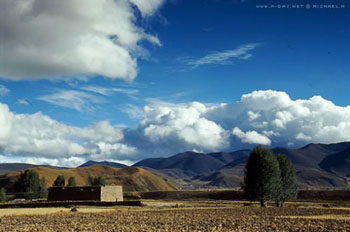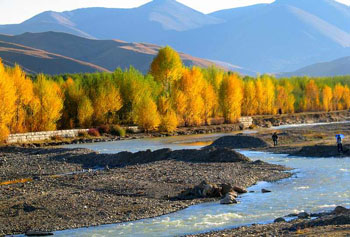search for a Trip
As the highest and most dramatic features of the natural landscape, mountains have an extraordinary power to evoke the sacred.
The ethereal rise of a ridge in mist, the glint of moonlight on an icy face, a flare of gold on a distant peak - such glimpses of transcendent beauty can reveal our world as a place of unimaginable mystery and splendor.
In the fierce play of natural elements that swirl about their summits -thunder, lightning, wind, and clouds -mountains also embody powerful forces beyond our control, physical expressions of an awesome reality that can overwhelm us with feelings of wonder and fear. "
Westerners used to describe Yading as above. Yading is located in Daocheng county in west of Sichuan province bordering with Yunnan Shangri-loa country. In the huge Konkaning Peaks, the three peaks of Xianlairi, Xialuoduojie and Yangmaiyong standing in the sky like armed gods guarding this sacred land. The locals adored the three peaks as Chenrezigs, Chanadorje and Jampayang.
The elevation of each scenic spot:
Ya Ding Village: 3180m
Chonggu Monastery: 3885m
Luorong Grazing: 4180m
The Niunai Hai: 4729m
The Wuse Hai: 5100m


Hell Valley:
It’s one of the eight skeleton forests in the world mentioned in the Buddha records. Its highest elevation is 3,800 meters and the lowest 2,500 meters, where clouds move past the valley among exotic mountain rocks. Looking in a close distance, visitors might feel scared over the sight of their shapes. The Hell Valley is lengthy and deep with primitive forests around, strange rocks inlaid, waterfalls giving shouting echoes.
Luorong Cattle Pasture:
It will take some time to get from the Chonggu Temple to the Luorong Meadow. The meadow is surrounded on three sides by the three snow peaks of Konka Risumgongba. A delightful contrast is formed by nearby snow peaks, forests, meadows, streams, lakes waterfalls and log houses. A highway starts from the Luorong Meadow and reaches Qu Jiuzha’a Godly Spring Well, from where people
Xiluo Cattle Pasture:
From Zhihuo Zhalang to the uphill Gonggayin steps, it will take an hour and half to get to the Xiluo Cattle Pasture (elev. 3,100m). The No. 1 Peak Shenrezig (elev. Of 6,032m) of the Konka Risumgongba mountain is close in sight.
Under the blue sky, the snow-white peak of Shenrezig erects high above the forests, shining a bright silvery light. After another 2 hours walk upwards, Zhazuo Yongyu(Horn Valley) is seen with luxuriant forests and murmuring streams by the sides. Not long after crossing the Gonggayin River is Zha’a Dongsuo (Cave of Immortals ), visitors may take a little rest here while enjoying the loud echoes by throwing stones to hit the cave walls. Hence this cave is also called the Stone Bell Rock, It takes another half a hour walk to get to the Yading Village (elev 3,890m). At this moment, the south side of Shenrezig is completely in sight. Walking upwards another hour, visitors come to the Chonggu Temple.
Zhihuo Zhalang:
In the Tibetan language, Zhihuo Zhalang means "shouting to drive off any barrier". It is a huge rock, regarded by local Tibetans as the God of the Mountain Gate. A sacred driver of local Tibetans, the Gonggayin River converges here and then pours into the Chitu River. According to the legend, lots of treasures were buried on the mountain. One day it rained cats and dogs because of the magic force of demons. All the treasure were rushed down into the Gonggayin River. Although the Gate God had tried all his best but he could not stop the rushing rive waters, he shouted off the barrier Hence the name of the rock. Every year at Saga Dawa (April 15 of the Tibetan calendar when Buddha was born – a day for someone to become immortal or nirvana), the folks will walk around the rock and then bathe in the river.
Mt. Echu:
In the Tibetan language, Mt. Echu means the "Shining Mountain". Its Lamuge Forest farm is the largest of Daocheng. The shape of Mt. Echu goes softly in widespread forests and changeable climate. In autumn, the whole mountain is colored by burgeoning trees and flowers, shining under the sun, just as indicated by its beautiful name. On Mt. Echu and overlooking at the Konka Risumgongba Peak, visitors are instantly overwhelmed by the mountain’s magnificence and splendor.
Mt. Haizi:
Have you ever calculated how far away your mind could travel? Right on Mt. Haizi, you will understand you have almost expended your mind to the sky, as in the same way as cagles in front, nearby steppe sheep, argali, hares and dry otters, as well as delicate grass and flowers at your feet. At this moment, you feel you are isolated, but pround and esteemed.
If you are a warrior longing for adventures and wonders, Mt. Haizi is a right place for a challenge. It is recorded as the "Daocheng ancient glacier cap"- the largest glacier heritage left over by the mountain formation of Himalayas. The land is at an average elevation of 3,600~5,020 meters and covers a total of 3,287 square kilometers.
By enjoying the distance you will see the boundless sky and captivating scenery on Mt. Haizi that will eventually shock your mind.
We would like to say that 1,145 alpine lakes are nothing but casual teardrops of the sky, scattering among the desolate rocks, as crystal clear as jade. Fish swim in great liberty in the piercing – cold lake waters, and seem to play with the birds inhabited along the banks. Small grass and flowers burst out of the stone seams, formulating an earthshaking beauty on this land 5,000 meters high.
And this once was also the homeland of dinosaurs. In 1982, scientists discovered the dinosaur teeth and eucalyptus fossils. If you are interested to pay a visit, it is very likely that you might be very lucky enough to pick up a dinosaur or ancient vegetation fossil among the rock piles. Here, every – thing is unknown, but everything is possible.
This is Mt. Haizi – the sea of mountains, the sea of lakes, the sea of stones and of vitality. She awaits you to explore this sea of the unknown.
Sangdui Valley:
The Sangdui Valley is noted for its spectacular scenery, open land along the highway and unpolluted rivers. In view from a distance, the mountain rises and falls, creating a picture majestic in all its variety. Villages, herdsmen and cattle are scattering here and there all in harmony with the nature. During his visit in the year 1144, the first ruler Gemaba Dusong Qinba spoke highly of the land, "I have traveled extensively in the Tibetan inhabited regions and found that this land has beautiful scenery plentiful pastoral grass and abundant livestock. And most important of all, this is a land where the Buddhist divine light sheds every of its comers. I would like to build a temple here to accumulate the virtues."
Pang River – Sela zone:
The biggest Cathay popular shelterbelt lies around the county town. Around it is miles of idyllic scenery zone of typical Kangpa Tibet area. The Tibet villages and Eco-tourism pastoral area are worth seeing. According to the agronomists, it is unable to grow in the places above the elevation of 4000 meters. However, plants and flowers are everywhere in this area. Cathay trees whirl in the air, the rivers wind through the woods, smoke curl up from the kitchen of the Tibetan houses and the Buddhist tower is well polished. And the most famous sceneries are the fog in the morning in Sela Village and the setting sun.
You can go to Ping River and Zhalang Monastery by minibus or on foot. If you walk there, you can go towards Ya Ding and soon arrive at the Cathay shelterbelt. Walk on for 20 minutes, and you find a muddy path on the right of the road. There’s a sign there with "Zhalang Monastery" on it. It is the way to Pang River and Zhalang Monastery.
Hot Spring:
The Rubucaka Hot Spring is 400 meters from the conty town. The colorless and tasteless spring water is clean and drinkable with a temperature of more than 68℃. Swimming in the water is good to health, blood circulation, endocrine secretion, and skin diseases. Most of Tibetan living nearby enjoy longevity.
Related Tours:
China Attractions Guide
- Anhui Attractions
- Beijing Attractions
- Chongqing Attractions
- Fujian Attractions
- Gansu Attractions
- Guangdong Attractions
- Guangxi Attractions
- Guizhou Attractions
- Hainan Attractions
- Henan Attractions
- Hongkong Attractions
- Hubei Attractions
- Hunan Attractions
- Inner Mongolia Attractions
- Jiangsu Attractions
- Jiangxi Attractions
- Manchuria Attractions
- Ningxia Attractions
- Qinghai Attractions
- Shaanxi Attractions


